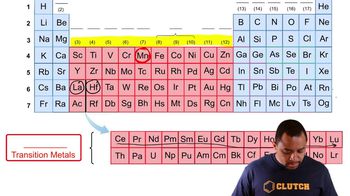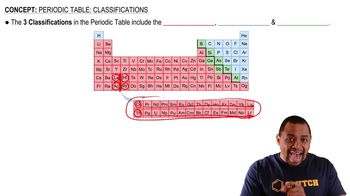The glycinate anion, gly-= NH2CH2CO2 -, bonds to metal ions through the N atom and one of the O atoms. Using to represent gly-, sketch the structures of the four stereoisomers of Co(gly)3.
Locate on the periodic table the transition elements with the following electron configurations. Identify each element.
(c) [Kr] 4d25s2
(d) [Xe] 4f36s2
 Verified step by step guidance
Verified step by step guidance
Verified video answer for a similar problem:
Key Concepts
Electron Configuration

Transition Elements

Periodic Table Positioning

Draw the structures of all possible diastereoisomers of an octahedral complex with the formula MA2B2C2. Which of the diastereoisomers, if any, can exist as enantiomers?
Locate on the periodic table the transition elements with the following electron configurations. Identify each element.
(a) [Ar] 3d74s2
(b) [Ar] 3d54s1
Look at the location in the periodic table of elements A, B, C, and D. What is the electron configuration of the transition metal in each of the following ions?
(c) C3+
(d) DO42-
What is the systematic name for each of the following molecules or ions? Include cis or trans prefixes for diastereoisomers. Platinum is Pt(II) in square planar complexes and Pt(IV) in octahedral complexes.
(1)
(2)
(3)
(4)
Consider the following isomers [Cr(NH3)2Cl4]-.
(a) Label the isomers as cis or trans.
(b) Which isomers are identical, and which are different?
(c) Do any of these isomers exist as enantiomers? Explain.
